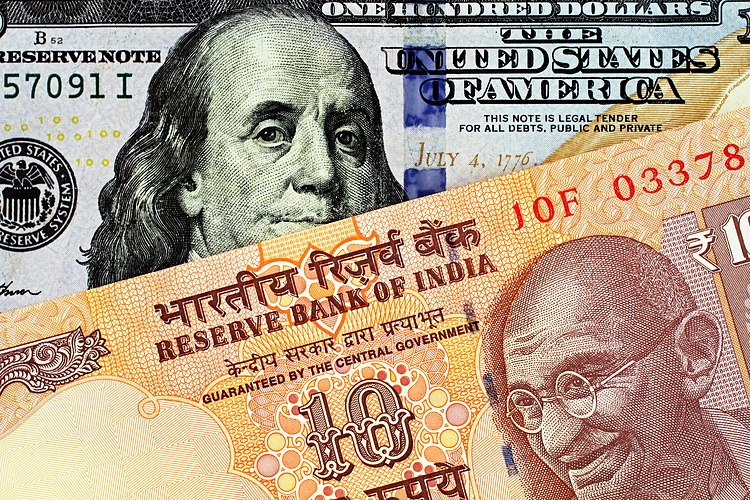- The Indian Rupee extends its downside in Thursday’s Asian session.
- Rising geopolitical tensions, Trump trades, and sustained portfolio outflows weigh on the INR.
- Traders brace for the US data and Fedspeak later on Thursday.
The Indian Rupee (INR) extends its decline on Thursday. The heightened geopolitical tensions and market reactions due to Donald Trump’s victory in the US presidential elections drag the local currency lower. Additionally, continuous foreign portfolio outflows might continue to undermine the INR in the near term.
Nonetheless, the Reserve Bank of India (RBI) is likely to intervene in the foreign exchange to mitigate further depreciation of the local currency, with state-run banks offering USD in the market. Later on Thursday, traders will monitor the US weekly Initial Jobless Claims, the Philadelphia Fed Manufacturing Index, Existing Home Sales, and the CB Leading Index, which are due later on Thursday. Also, the Federal Reserve’s (Fed) Beth Hammack and Austan Goolsbee are scheduled to speak.
Indian Rupee weakens amid sustained portfolio outflows and geopolitical risks
- India’s economic growth is expected to pick up in the current quarter after a slowdown in July-September, the RBI said in its monthly bulletin on Wednesday.
- The Indian central bank projected third-quarter Gross Domestic Product (GDP) growth at 7.6%, faster than an estimated 6.7% in the second quarter.
- Indian Rupee fell by 7.8% during FY23 and by 1.4% in FY24. It has depreciated by 1.5% so far in FY25, according to the RBI.
- Federal Reserve Board of Governors member Michelle Bowman said on Wednesday that inflation is still elevated and moving sideways in the last few months and the US central bank should pursue a cautious approach to monetary policy.
- Futures traders are now pricing in a 54% chance that the Fed will cut rates by a quarter point, down from around 80% last week, according to data from the CME FedWatch Tool.
USD/INR’s broader trend remains constructive
The Indian Rupee softens on the day. The USD/INR pair keeps the bullish vibe as the price holds above the ascending channel throwback support on the daily time frame. The 14-day Relative Strength Index (RSI) is located above the midline around 66.70, suggesting that the further upside looks favorable.
The all-time high of 84.45 appears to be a tough nut to crack for the bulls. A decisive break above this level could still take the pair up to the 85.00 psychological level.
On the other hand, sustained bearish momentum below the resistance-turned-support level at 84.35 could pave the way to the 84.00-83.90 zone, representing the round mark and the 100-day EMA.
Indian Rupee FAQs
The Indian Rupee (INR) is one of the most sensitive currencies to external factors. The price of Crude Oil (the country is highly dependent on imported Oil), the value of the US Dollar – most trade is conducted in USD – and the level of foreign investment, are all influential. Direct intervention by the Reserve Bank of India (RBI) in FX markets to keep the exchange rate stable, as well as the level of interest rates set by the RBI, are further major influencing factors on the Rupee.
The Reserve Bank of India (RBI) actively intervenes in forex markets to maintain a stable exchange rate, to help facilitate trade. In addition, the RBI tries to maintain the inflation rate at its 4% target by adjusting interest rates. Higher interest rates usually strengthen the Rupee. This is due to the role of the ‘carry trade’ in which investors borrow in countries with lower interest rates so as to place their money in countries’ offering relatively higher interest rates and profit from the difference.
Macroeconomic factors that influence the value of the Rupee include inflation, interest rates, the economic growth rate (GDP), the balance of trade, and inflows from foreign investment. A higher growth rate can lead to more overseas investment, pushing up demand for the Rupee. A less negative balance of trade will eventually lead to a stronger Rupee. Higher interest rates, especially real rates (interest rates less inflation) are also positive for the Rupee. A risk-on environment can lead to greater inflows of Foreign Direct and Indirect Investment (FDI and FII), which also benefit the Rupee.
Higher inflation, particularly, if it is comparatively higher than India’s peers, is generally negative for the currency as it reflects devaluation through oversupply. Inflation also increases the cost of exports, leading to more Rupees being sold to purchase foreign imports, which is Rupee-negative. At the same time, higher inflation usually leads to the Reserve Bank of India (RBI) raising interest rates and this can be positive for the Rupee, due to increased demand from international investors. The opposite effect is true of lower inflation.
Read the full article here

